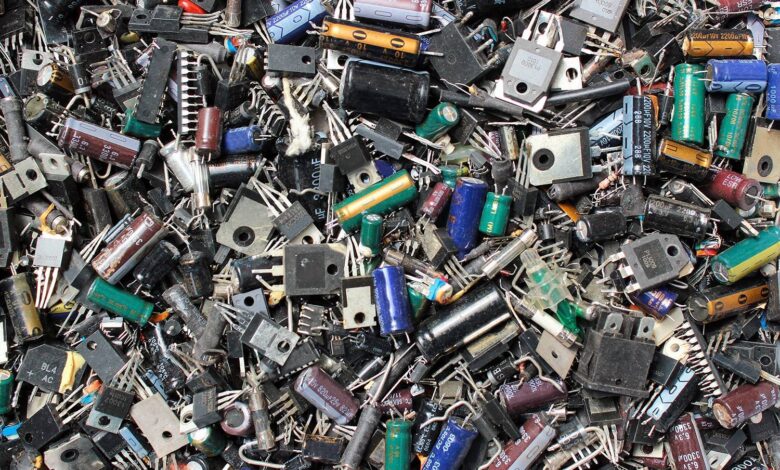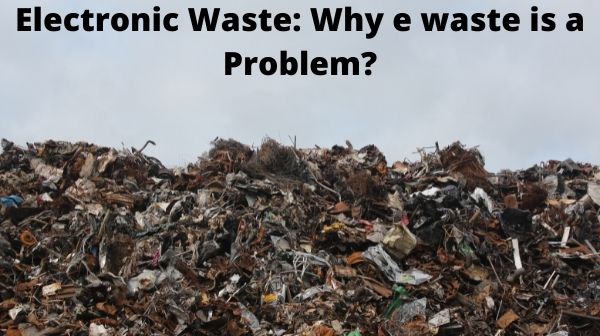Electronic Waste: Why e waste is a Problem?

The acronym “e waste” stands for “electronic waste and electrical trash.” Electronic products that are undesired, broken, or approaching or even at the conclusion of their “expected lifetime” are referred to as e-waste.
Electronic items such as desktops, televisions, Video recorders, stereo systems, copy machines, and photocopiers are commonplace.
The problem about how to properly handle of the used undesired gadgets isn’t new; it dates back to the early the 1970s. But a world has happened since then, specifically in terms of the amount of electronics that are now thrown.
Any wasted electrical or electronic equipment is referred to as e waste. This covers both functioning and defective things that are discarded or transferred to a charity reseller such as Salvation. If an item remains unwanted in a business, it is frequently discarded.
Toxic compounds typically escape from the elements inside e-waste when it is interred, making it extremely harmful.
Everything having connectors, cables, or electrical devices is considered e waste (electronic garbage). Television sets, laptops, cellular phones, and any form of home device, including air conditioning units to children’s toys, are common contributors of e waste.
The Six Waste Categories of Electronic Waste
It is universally recognized that e-waste encompasses six types of waste:
Temperature exchange
Appliances, freezers, air conditioning units, and heating systems are examples of thermal interchange technology, often known as chilling and thawing devices.
Screens & Monitors
Televisions, monitors, computers, notebooks, and tablets are all examples of electronic devices.
Lamps
LED lighting, fluorescent lighting, and high-intensity discharge light bulbs
Large Equipment
Household appliances, textiles dryers, dishwasher machines, electrical stoves, huge inkjet prints, copying apparatus, and photovoltaic are all examples of large printing devices, copying machinery, and solar systems.
Small equipment
Hoovers, electrical appliances, havoc equipment, household appliances, energy into electricity, beard trimmers, measurements, slide rules, broadcasting sets, video recorders, electrical & mechanical toys, small electrical & mechanical tools, small medical equipment, and comparatively tiny control and monitoring instruments are all examples of small electrical products.
Small IT and Telecommunications equipments
Mobile phones, Global Positioning Systems (GPS), pocket calculators, routers, computers, printers, and telephones are all examples of electronic devices.
The fundamental role of each subcategory differs. Thickness, size, and material composition, as well as the lifespan, are all factors to consider. Additionally, there are disparities in the volume and quality of e-waste between both the subcategories, culminating in variable economic contribution as well as serious environmental and health implications from improper recycling purposes.
As a result, when discarding of electrical and electronic products, the collecting and logistics operations, as well as the disposal technologies, change for each classification, much as customers ’ attitudes varies.
E-Waste is one of the fastest growing waste streams
According to the Global E waste Monitor 2017, e waste has increased to 44.7 million metric tones per year. However, only 20% of the e waste produced is reported as being recovered and repurposed.
The destiny of the remaining 76 percent (34.1 million metric tones) is uncertain, however it is probable that they were discarded, exchanged, or repurposed in deplorable conditions. Much e waste is also left in the homeowners’ outbuildings, crawl spaces, and storage areas, or is thrown out in a regular family receptacle.
Since worldwide consumer consumption is increasing, e waste is expanding at an accelerating rate. Furthermore, e waste is growing as a result of increased technology acceptance and faster renewal intervals.
Because more and more regions of this improvement and growth transcend the ‘Digital Divide,’ the modern customers’ expectations the ability to live a simpler, more satisfying life. However, this perfectly reasonable desire presents a cascading issue of treatment and disposal.
Why is e Waste a problem?
The United Kingdom is presently another of the world’s leading manufacturers of domestic e-waste. Toxic chemicals such as mercury and lead can leak into water and soil whenever damaged or unneeded devices are discarded in landfills.
Gold, silver, copper, platinum, aluminium, and cobalt are among the non-renewable materials found in gadgets. This means so when people disposed with them without recovering items, they are wasting valuable resources.

Current E waste recycling Solutions are just exporting the problem
Regeneration is a better choice than dumping precious components in landfills, and it has its own moral questions. Procedures are wasteful and cumbersome, and governments are transferring the problem to governments wherein workers are not protected by labor protections or regulations when handling e-waste for mining and metal exploitation.
‘Complete systems being shipped to China, Africa, or India, where entire villages of youngsters sort components,’ says one source. What humans need is someone able to manufacture items here and get a deeper understanding of where components are located throughout particular models.
Humans should build them to become more completely recyclable, with improved branding and architecture allowing organizations which work to be electronic recycling and valuable materials to be saved from garbage.’
The Great Global Challenge
Due to the obvious characteristics of trash creation and e waste management in a globalization era, the e-waste crisis is of worldwide importance.
It’s hard to estimate worldwide e-waste levels, but it’s recognized that substantial amounts end up in situations wherein suitable recycling programs aren’t yet in place, or where primitive methods have been used to derive meaningful elements whilst dangerous elements are dumped in often waste disposal.
This raises questions concerning recycling and reuse as well as urgent health and environmental implications. Many jurisdictions, on the other hand, have acknowledged such a need to appropriately recover e-waste and are attempting to establish long-term alternatives.
This approach is being aided by worldwide collaboration and integration in order to guarantee that the possibilities presented by various conditions can be leveraged to eventually improve increased recycling processes.
How to recycle mobile phones, computers and other electronics-
Postpone upgrading for as long as you can
If people are thinking about upgrading their phone or other devices, think carefully. Is a new device truly necessary for some of people to conduct their job or connect effectively with others?
Find opportunities for reuse
Consider gifting it to anyone else that it is still in good condition and then only needed routine maintenance. If friends or family do not want to be, there are a lot of charity that will accept it and appreciate old stuff, particularly cell phones.
Read Also- Fortnite Season 3 Battle Pass and June Crew Pack Leaked
Try returning the item to the manufacturer
The producer should indeed be contacted first because the item is defective or useless. Inquire about their policy for exchanging obsolete electronics and supplies for compensation.
The majority of people will not return products at the end of respective professional lifetime, but others will, and that the only method marketplace practice and responsibility will improve is if sufficient people are demanding it.
What are the main causes of e-waste?
Many electronic items become obsolete in a very short period of time due to constant technological improvement, resulting in a massive surplus of useless electronic products, or “e-waste.” The disposal of e-waste in landfills has the potential to endanger both human and environmental health.
What is the world impact of e-waste?
Hundreds of different elements and hazardous chemicals are present in this e-waste. Lead, arsenic, cadmium, mercury, and flame retardants are among the substances on this list. As a result, all of these seep into the environment during primitive e-waste disposal, posing major human health and environmental hazards.






